Hiatus Hernia and Its Impact on GERD Symptoms
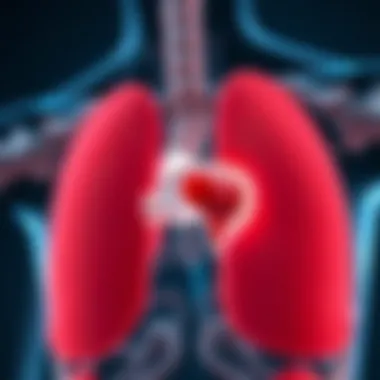
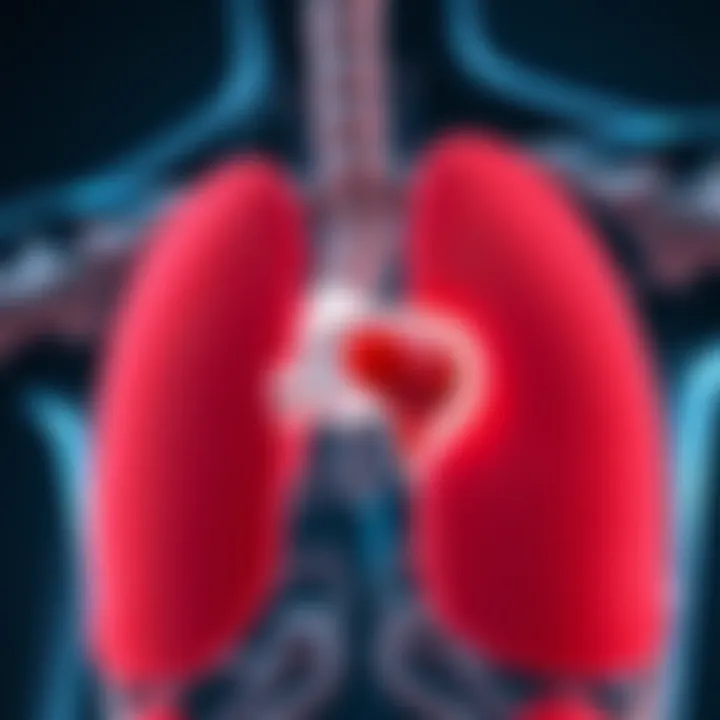
Intro
Navigating the labyrinth of digestive health can sometimes feel like an uphill battle. Among the prominent conditions that can complicate this journey are hiatus hernias and gastroesophageal reflux disease, often known as GERD. Many individuals experience discomfort related to these ailments, yet understanding their connection can provide the clarity needed for effective management and treatment.
Often, hiatus hernias slip under the radar until they trigger symptoms that leave individuals seeking answers. A hiatus hernia occurs when part of the stomach bulges through the diaphragm into the chest cavity. This anatomical shift can affect how the body regulates stomach acid, leading to the all-too-familiar woes of GERD, where acid that should remain where it belongs instead finds its way up the esophagus.
As we delve deeper into this topic, the relationship between these two conditions will be fleshed out. We will highlight the symptoms, diagnostic approaches, and management strategies that can ease the lives of those affected. Understanding these aspects can empower patients and their healthcare providers with the knowledge needed to tackle these challenging issues head-on.
Research Background
Overview of the scientific problem addressed
The intricate interplay between hiatus hernia and GERD is a significant area of investigation in gastroenterology. Traditionally, gastroesophageal reflux has been viewed as a condition arising from a malfunctioning lower esophageal sphincter. However, with the growing recognition of hiatus hernias, researchers have begun unraveling the layers of complexity that this hernia adds to the reflux dilemma. The association seems to be more than mere coincidence, as studies suggest anatomical changes provoked by a hiatal hernia can predispose individuals to heightened acid reflux symptoms.
Historical context and previous studies
Research has a long standing history of delving into the nexus between these two conditions. Early studies primarily focused on symptomatic treatment of GERD with medications. However, as surgical techniques developed, interest surged in how repairing hiatus hernias could lead to improved outcomes for reflux patients. For example, the landmark studies conducted in the late 20th century began outlining the potential benefits of surgical intervention, thereby setting the stage for ongoing research that zeroes in on long-term effects and patient quality of life. With the ever-evolving understanding of pathophysiology, recent analyses have integrated newer diagnostic modalities and treatment options, pushing boundaries on how we manage these interconnected conditions.
Findings and Discussion
Key results of the research
A notable finding in the realm of hiatus hernias and GERD is that about 60% of patients with GERD also exhibit a form of hiatus hernia. Researchers have underscored this correlation, concluding that the severity of reflux symptoms often correlates with the size of a hiatus hernia. This observation is enlightening; it lends credence to the hypothesis that larger hernias may induce higher gastroesophageal pressure gradients, making reflxing more likely.
Interpretation of the findings
The implications of these findings are profound. They suggest that not treating an underlying hiatus hernia could mean patients struggle unnecessarily with GERD symptoms. In cases where lifestyle modifications or medications fail to relieve symptoms, surgical intervention may become a worthy consideration. A comprehensive understanding of how hiatus hernias exacerbate GERD helps in crafting individualized treatment plans that are both effective and far-reaching.
"Understanding the link between hiatus hernias and GERD isn’t just academic; it can shape the treatment approach and ultimately improve patient outcomes."
As we move forward, we will continue to explore various dimensions, including symptoms, diagnostic methods, management strategies, potential complications, and lifestyle adjustments that are essential for those grappling with these intertwined conditions.
Prolusion to Hiatus Hernia
Hiatus hernia is a medical condition that often leads to troublesome symptoms and complications, frequently tying in with gastroesophageal reflux disease (GERD). Understanding this condition is crucial because it affects how we comprehend related health issues and manage symptoms effectively. In this article, we strive to shed light on hiatus hernia by dissecting its essence and overarching impact on GERD.
The significance of this topic can’t be understated. Many individuals live with symptoms that could be linked back to a hiatus hernia without understanding the underpinnings of their discomfort. This section aims to equip readers with foundational knowledge about hiatus hernia, elucidating its definition, types, and implications for health.
Definition and Overview
A hiatus hernia occurs when part of the stomach pushes through the diaphragm into the chest cavity. The diaphragm usually separates the abdominal cavity from the chest. Essentially, when there’s a rupture or weakness, this herniation happens, leading to potential reflux and other digestive disturbances. Knowing this brings clarity to why some people experience discomfort after meals or while lying down.
There are two main types of hiatus hernia: sliding and paraesophageal. Understanding the distinctions between these types helps decode their respective relationships with GERD.
Types of Hiatus Hernia
The world of hiatus hernia is not a monolith. While they share similar characteristics, the two primary types—sliding hiatus hernia and paraesophageal hiatus hernia—differ significantly in their mechanisms and consequences.
Sliding Hiatus Hernia
Sliding hiatus hernia is the most common form. In this case, the lower esophagus and the stomach move above the diaphragm into the thoracic cavity together. This movement typically occurs when the person lies down or exerts pressure on the abdomen, like during heavy lifting or straining. The key characteristic of this type is its tendency to move back and forth—hence the term “sliding.”
This type is relevant because it is often linked with GERD symptoms. The sliding motion allows acids to more easily travel back up the esophagus, leading to that familiar burning sensation many experience. Sliding hernias can often be managed with lifestyle changes, making it a relatively less daunting issue for many. However, there’s still the chance of flare-ups that must be addressed, particularly with dietary adjustments or medications.
Paraesophageal Hiatus Hernia
In contrast, paraesophageal hiatus hernia occurs when part of the stomach pushes through the diaphragm next to the esophagus, often remaining stationary while the esophagus stays in place. A key characteristic of this type is that it doesn’t slip back and forth like the sliding variant. This fixed hernia may lead to more serious complications, as portions of the stomach can become trapped, risking strangulation or blood supply reduction.
Paraesophageal hernias are not as common, but they demand attention due to their potential for serious outcomes. Unlike their sliding counterparts, these often require surgical intervention if symptoms become severe or frequent, underscoring the gravity of the situation.
By diving into the various forms of hiatus hernia, we gain insights into their potential to exacerbate conditions like GERD. This understanding is pivotal for healthcare professionals and patients alike, laying the groundwork for effective management strategies.
Understanding Gastroesophageal Reflux Disease
Gastroesophageal reflux disease, commonly known as GERD, represents a significant concern for many individuals, particularly those suffering from hiatus hernia. Understanding this condition is pivotal for grasping how it intertwines with hiatus hernia pathology. GERD is fundamentally characterized by the backflow of stomach contents into the esophagus, leading to a myriad of uncomfortable and sometimes severe symptoms.
Definition and Symptoms
In simple terms, GERD occurs when the lower esophageal sphincter (LES), a muscular ring that acts as a valve between the esophagus and the stomach, does not close properly. This malfunction allows acidic stomach contents to creep back up into the esophagus, causing irritation and inflammation.
Some of the most commonly reported symptoms of GERD include:
- Heartburn: A burning sensation in the chest, often after eating, which may worsen at night.
- Regurgitation: The sensation of acid backing up into the throat or mouth, with a sour or bitter taste.
- Dysphagia: Difficulty swallowing, where food feels like it's stuck in the esophagus.
- Chest Pain: Sometimes, GERD can mimic heart-related issues, causing significant concern among patients.
Mild cases may present sporadic symptoms, while more severe instances can lead to chronic discomfort, significantly affecting one’s quality of life. It’s crucial for individuals experiencing these symptoms to seek medical attention, particularly since untreated GERD can lead to more serious complications.
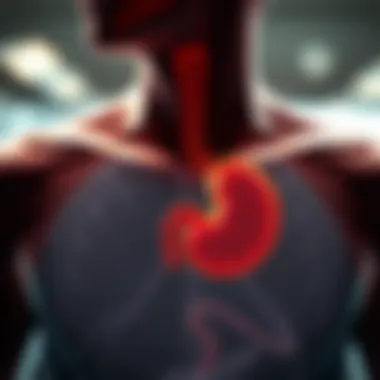
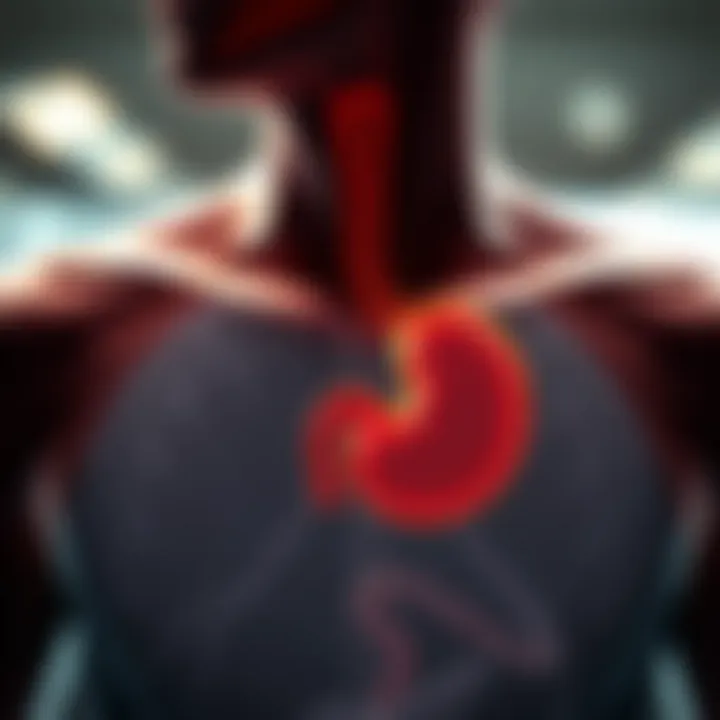
Causes of GERD
Understanding the root causes of GERD is essential for effective management. Various factors can contribute to the dysfunction of the LES:
- Hiatus Hernia: When a portion of the stomach bulges through the diaphragm into the chest cavity. This anatomical change can compromise the functioning of the LES.
- Obesity: Excess weight increases abdominal pressure, which can prompt the stomach to push acid up into the esophagus.
- Pregnancy: Hormonal changes and increased pressure on the stomach during pregnancy can lead to GERD.
- Dietary Habits: Consumption of certain foods and beverages, such as chocolate, caffeine, spicy dishes, and alcohol, can also trigger reflux episodes.
- Smoking: Tobacco use can weaken the LES, exacerbating reflux problems.
- Medications: Some drugs, including certain antihistamines, painkillers, and blood pressure medications, can relax the LES which may lead to symptoms.
Recognizing these causative factors helps in tailoring lifestyle changes and treatment plans to mitigate the symptoms effectively.
The interplay between hiatus hernia and GERD underscores the complexity of managing digestive disorders, necessitating a comprehensive understanding of both conditions for effective treatment.
For a deeper insight into management strategies, consider resources from trusted medical sites such as Mayo Clinic or look into scholarly articles in medical journals to enhance your understanding.
The Pathophysiology of Hiatus Hernia
Understanding the pathophysiology of hiatus hernia is crucial to unraveling its impact on gastroesophageal reflux disease (GERD). This condition arises mainly from the movement of the stomach into the thoracic cavity through the diaphragm. The diaphragm usually serves as a barrier between the abdominal cavity and the thoracic cavity, helping to maintain proper pressure dynamics in the esophagus. When a hernia occurs, it disturbs this balance, leading to a cascade of physiological changes that can exacerbate GERD symptoms.
Anatomical Changes
In hiatus hernia, anatomical changes play a pivotal role. The movement of the stomach creates an alteration in the shape and position of the gastroesophageal junction. This junction is critical in preventing the backflow of acid and partially digested food into the esophagus.
- Displacement of the Lower Esophageal Sphincter (LES): The hernia allows the LES to reside above the diaphragm, making it less effective at preventing reflux. The sphincter no longer has the same anchoring support, leading to potential incompetence.
- Altered Pressure Dynamics: With the stomach sitting higher, the normal pressure differentials that prevent acid from entering the esophagus are disrupted. Instead of high pressure below the diaphragm and lower pressure above, the balance shifts, favoring reflux.
- Anatomical Distortions: Torn connective tissues can lead to changes in the esophagus's length and axis, which further complicates its function.
Visualizing the situation offers more than just an anatomical diagram. It's more like understanding a teeter-totter in a playground; if one side rises too high, the other inevitably dips, leading to imbalance.
Impact on Esophageal Function
The impact of these anatomical changes extends beyond mere discomfort. It transforms the esophageal functionality on multiple levels:
- Inefficient Peristalsis: Once the anatomical integrity is compromised, the esophagus struggles to perform coordinated contractions, which normally push food and liquids down into the stomach. Instead, a sluggish response can lead to food staying longer in the esophagus, increasing the chances of irritation and reflux.
- Increased Exposure to Gastric Acid: With reflux becoming more prevalent, the esophagus is at greater risk of damage from gastric acid, leading to inflammation and even chronic conditions like esophagitis.
- Dysphagia: Patients may experience difficulties with swallowing, a symptom that could stem from both actual obstruction and from discomfort caused by esophageal inflammation.
"The physiological interplay in a hiatus hernia is not merely about the hernia itself; it's about the domino effect that unfolds, impacting the entire digestive pathway."
Understanding these dynamics is essential for healthcare providers focusing on individualized treatment plans. Each patient's unique presentation can guide the decision-making process regarding lifestyle changes, medications, or even surgical options.
In summary, the pathophysiology of hiatus hernia shows us not just the structural changes involved but also the functional repercussions that can lead to significant clinical symptoms, notably GERD. Any treatment approach must consider both the anatomical and functional aspects to address the complete picture effectively.
The Connection Between Hiatus Hernia and GERD
Understanding the connection between hiatus hernia and gastroesophageal reflux disease (GERD) is crucial in comprehending how these conditions interact and affect patients' quality of life. Hiatus hernia often serves as a significant factor in exacerbating GERD symptoms due to the anatomical changes and physiological disruptions it causes in the esophageal region. This section will delve into the mechanisms of reflux enhancement and the prevalence of GERD among those suffering from hiatus hernia, weaving together the threads of these related health issues.
Mechanisms of Reflux Enhancement
Hiatus hernia creates an environment that is particularly favorable for the development and worsening of GERD. When the stomach bulges through the diaphragm into the chest cavity, it alters the normal function of the lower esophageal sphincter (LES), which usually acts as a barrier to prevent stomach acid from flowing back into the esophagus. This disruption can lead to the following mechanisms of reflux enhancement:
- Increased Abdominal Pressure: As the stomach herniates upward, increased pressure can cause the LES to weaken, allowing more acid to escape.
- Altered Esophageal Motility: The anatomical changes may disrupt the normal peristaltic movements of the esophagus, slowing down the clearance of refluxed acid, meaning that acid stays in the esophagus longer.
- Loss of Diaphragmatic Support: The diaphragm usually helps to keep the LES closed. When the diaphragm moves upward due to a hiatal hernia, this support is compromised, furthering the risk of acid reflux.
While all these mechanisms become intertwined to escalate the severity of GERD symptoms, they also complicate the management of these patients. Therefore, recognizing these connections is essential for appropriate treatment planning.
Prevalence of GERD in Hiatus Hernia Patients
Research indicates a notable increase in the prevalence of GERD among individuals diagnosed with hiatus hernia. Various studies suggest that approximately 40% to 70% of patients manifest GERD symptoms, underscoring the significance of this relationship. In fact, a systematic review published in the Journal of Gastroenterology reveals a strong correlation between the two conditions.
Several factors contribute to this heightened prevalence:
- Age: Older adults are more likely to experience both conditions, with declining muscle tone contributing to the onset of hiatus hernia.
- Obesity: The increasing rates of obesity amplify both hiatus hernia formation and GERD symptoms, creating a vicious cycle.
- Lifestyle Factors: Dietary habits, smoking, and alcohol consumption may exacerbate symptoms, leading to more severe reflux issues.
The recognition of this higher prevalence is not merely academic; it affects clinical decision-making and patient management strategies.
"Understanding the interplay between hiatus hernia and GERD is essential for effective diagnosis and treatment, ensuring that patients receive tailored care for their specific conditions."
In summary, the connection between hiatus hernia and GERD is a significant area of focus. By grasping the mechanisms enhancing reflux and acknowledging the prevalence of GERD in patients with hiatus hernia, healthcare professionals can adopt more informed approaches in managing these concurrent conditions, paving the way for better health outcomes.
Clinical Implications of Hiatus Hernia and GERD
Understanding the clinical implications of hiatus hernia, especially in relation to gastroesophageal reflux disease (GERD), is pivotal for effective patient care. Hiatus hernia can create an array of symptoms, and when these overlap with GERD, the complications can further impede a patient’s quality of life.
First and foremost, patients diagnosed with a hiatus hernia often find themselves in a loop of continuous discomfort due to frequent heartburn and regurgitation associated with GERD. It's crucial for healthcare providers to grasp how these two conditions influence each other. This knowledge allows for a tailored approach to treatment that not only addresses the symptoms but also targets the underlying issues.
Diagnosis of Hiatus Hernia
Diagnosing a hiatus hernia can prove tricky, as its symptoms can mirror those of other gastrointestinal disorders. Fundamentally, the medical history, physical examination, and specific diagnostic tests play key roles in identifying this condition. Patients typically present complaints of chest pain, swallowing difficulties, or chronic cough. However, these symptoms may lead to misdiagnosis if not carefully evaluated.
The healthcare provider may consider the following:
- Symptoms Assessment: A thorough discussion of the patient’s symptoms and their duration.
- Physical Examination: Check for signs such as abdominal tenderness or distension, which can provide clues.
- Radiologic Studies: An X-ray or fluoroscopy can be instrumental in visualizing the herniation of stomach tissue.
Proper diagnosis, making use of a combination of these methods, is the first step toward effective management and helping patients find relief from their symptoms.
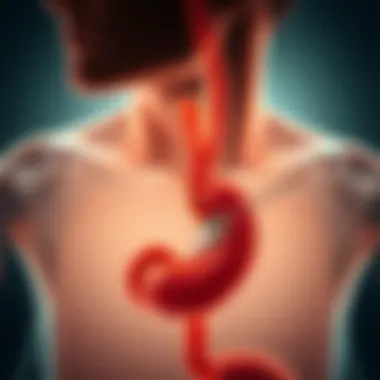
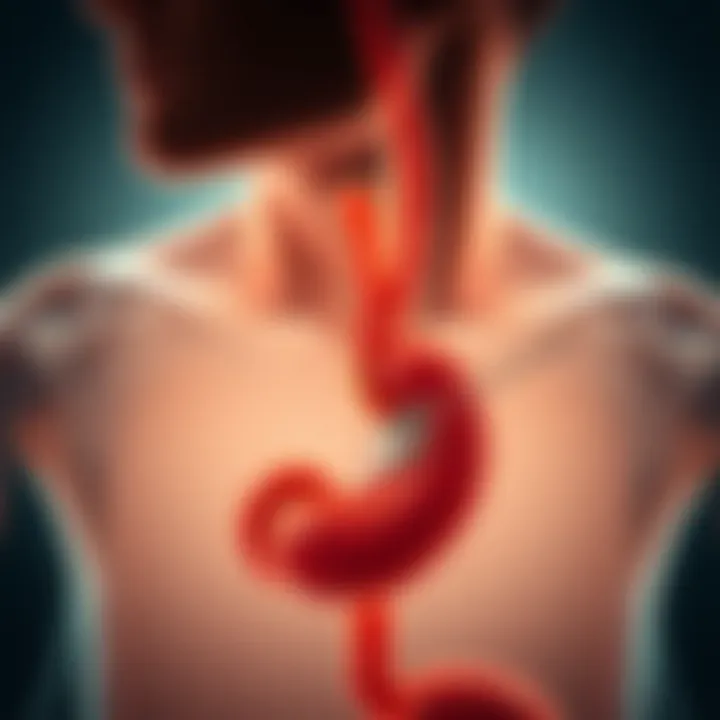
Role of Endoscopy and Imaging
Endoscopy and imaging techniques are invaluable in the diagnosis and management of hiatus hernia and associated GERD. These tools not only provide direct visualization of the esophagus and stomach but also allow the assessment of the severity of tissue damage, if present.
- Upper Endoscopy (EGD): This procedure involves inserting a flexible tube with a camera through the throat to examine the esophagus and stomach lining. It helps identify inflammation, ulcers, or Barrett's esophagus— conditions that may arise due to chronic reflux.
- Barium Swallow Studies: Patients consume a barium solution prior to X-ray imaging. This technique can highlight any abnormal protrusions through the diaphragm, clearly showing the presence of a hiatus hernia.
- Esophageal Manometry: While not always standard, this investigation evaluates the motility of the esophagus. It provides crucial insights into how well the esophagus moves food along and can reveal sphincter function.
Incorporating effective imaging and endoscopic techniques enhances diagnostic accuracy, enabling healthcare providers to formulate robust treatment plans tailored to each patient's needs.
"Correct diagnosis and prompt management are critical to improving the patients' quality of life who suffer from both hiatus hernia and GERD."
In summary, understanding the clinical implications of hiatus hernia and its interplay with GERD is essential. It provides a pathway for effective diagnosis, ensures appropriate management strategies, and ultimately aims to improve a patient's overall well-being.
Management Strategies for Patients
Managing a hiatus hernia, particularly in the context of gastroesophageal reflux disease (GERD), requires more than just medical intervention. Effective management strategies often combine lifestyle changes with medical treatments to enhance patient outcomes and comfort. It’s essential to recognize that every individual’s situation is unique, emphasizing the importance of personalized management plans. Not only do these strategies aim to alleviate symptoms, but they can also help in preventing complications that may arise from untreated reflux issues.
Lifestyle Modifications
Lifestyle choices play a significant role in managing hiatus hernia and GERD. These changes vary from dietary alterations to sleep habits, as they directly affect the frequency and severity of reflux episodes.
Dietary Changes
Dietary choices can substantially influence reflux symptoms. Patients are often encouraged to avoid specific food triggers such as spicy dishes, chocolate, caffeine, and fatty foods. These foods can relax the lower esophageal sphincter, allowing stomach acids to escape back up into the esophagus, which is not good for someone with a hiatus hernia. The key characteristic of dietary changes is the potential for symptomatic relief; it’s a simple yet effective strategy to lessen discomfort.
One unique aspect of dietary changes is the emphasis on smaller, more frequent meals rather than larger, heavier ones. This can lessen pressure on the stomach and reduce the chances of reflux. However, it is essential to note that while many find relief through these changes, altering diet can be challenging and requires diligence to maintain a balance of nutrients.
Weight Management
Maintaining a healthy weight is another critical factor in managing hiatus hernia and GERD. Excess weight, particularly around the abdomen, can put additional pressure on the stomach, leading to increased acid reflux phenomena. The importance of weight management in this context cannot be overstated; it serves as a foundational aspect of overall health as well.
A key feature of weight management is its dual benefits: not only does it reduce GERD symptoms, but it also enhances overall well-being. Most patients find that when they effectively shed a few pounds, they experience significant improvements in their condition. Nonetheless, embarking on a weight loss journey requires commitment, and some may struggle with motivation and sustaining lifestyle changes.
Sleeping Position
The way one sleeps can have a notable impact on hiatal hernia symptoms. Elevating the head while sleeping can prevent overnight reflux episodes, allowing for a more restful and uninterrupted night. Users often find that sleeping on their left side can additionally help in reducing reflux because of anatomical positioning.
This simple modification is great because it doesn’t require medications or complicated routines — just a few pillows can often do the trick! However, it's crucial to ensure that the elevation is comfortable and does not create neck or back pain.
Medical Treatments
Sometimes, lifestyle changes alone may not suffice, prompting the consideration of medical treatment options. These treatments can range from over-the-counter antacids to prescription medications designed to manage symptoms effectively.
Antacids and Acid Reducers
Antacids provide quick relief by neutralizing stomach acid. They are often the first line of defense for many, as their availability over-the-counter makes them a popular choice. The key characteristic of antacids is their speed; they can ease discomfort within minutes, providing temporary relief.
However, the downside is that they only serve as a short-term solution. While they can control immediate symptoms, they do not address the underlying issues related to hiatus hernia and GERD. Extensive reliance on ammonium compounds can lead to side effects such as constipation or diarrhea, hence they are not advised for long-term use.
Prokinetic Agents
Prokinetic agents are aimed at enhancing gastric motility, helping the stomach empty faster. This can be useful in reducing symptoms related to acid reflux. A significant aspect of prokinetic agents is how they act at the cellular level to strengthen the lower esophageal sphincter and improve esophageal clearance, thus reducing the likelihood of reflux.
One unique feature of these drugs is their multifaceted approach to treatment. They not only manage current symptoms but also aim to prevent future occurrences by improving gastrointestinal function. Still, they are not without drawbacks; these agents can lead to side effects, such as fatigue and, in some cases, more severe neurological effects, making close monitoring essential.
Surgical Interventions
Surgical interventions are often considered when conservative treatments for hiatus hernia and associated gastroesophageal reflux disease do not yield satisfactory results. For many patients suffering from chronic GERD unresponsive to medication and lifestyle changes, surgery might provide a more permanent solution. This section emphasizes the indications and common techniques used in surgeries, giving a more nuanced understanding of how these procedures can drastically improve a patient's quality of life.
Indications for Surgery
Not every case of hiatus hernia necessitates surgical intervention. The decision often hinges on several factors, such as:
- Severity of Symptoms: Patients facing severe or debilitating GERD symptoms, despite optimal medical management, may be ideal candidates for surgery.
- Frequency of Complications: Individuals who experience recurrent complications such as esophagitis, strictures, or Barrett's esophagus might require surgical options to prevent chronic damaging effects.
- Patient's Quality of Life: When day-to-day living becomes a challenge due to pain, discomfort, or reliance on medications, surgery can significantly enhance well-being.
- Anatomical Considerations: Specific characteristics of the hernia, like a large paraesophageal hernia that risks incarceration, are critical in deciding if surgery is needed.
Opting for surgical intervention is a significant decision and frequently involves a thorough discussion between the physician and the patient about the risks, benefits, and potential outcomes.
Common Surgical Techniques
Two of the most frequently used surgical techniques for hiatus hernia are Nissen fundoplication and laparoscopic surgery. Each technique has its own characteristics and considerations.
Nissen Fundoplication
Nissen fundoplication is a well-established surgical procedure aimed at treating issues related to acid reflux and hiatus hernia. This technique involves wrapping the top part of the stomach around the lower esophagus, effectively reinforcing the lower esophageal sphincter (LES). A few points to note:
- Key Characteristic: The key aspect is that it creates a barrier to reflux, reducing the likelihood of stomach acid flowing back into the esophagus.
- Why It's Popular: Many surgeons endorse Nissen fundoplication due to its relative effectiveness in mitigating reflux symptoms and restoring normal esophageal function. Studies indicate high success rates in both short-term and long-term outcomes.
- Unique Feature: Its uniqueness lies in how it can be performed via open or laparoscopic methods. The laparoscopic approach offers the benefit of smaller incisions and faster recovery times.
- Advantages/Disadvantages: While quite effective, patients may face potential side effects like dysphagia (difficulty swallowing) or gas bloating. These issues, while typically manageable, might deter some individuals from undergoing the procedure and require careful post-operative monitoring.
Laparoscopic Surgery
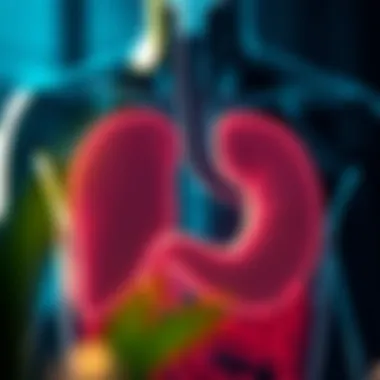
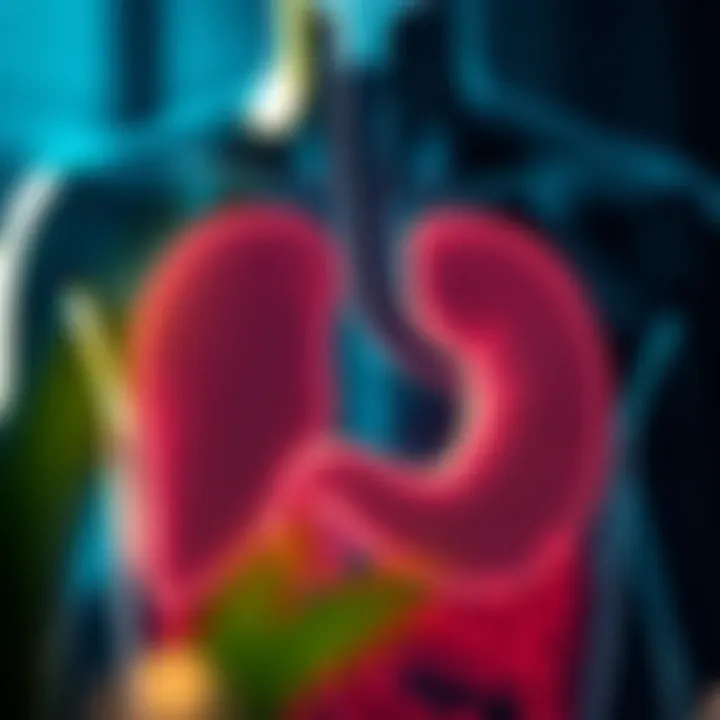
Laparoscopic surgery, on the other hand, is a minimally invasive technique that has gained popularity for its advantages, including reduced recovery time and less postoperative discomfort. This technique can be applied for various conditions, including hiatus hernia. Here are some distinctive aspects:
- Key Characteristic: The operation involves several small incisions rather than a single large one, which results in less tissue trauma and quicker healing.
- Why It's Beneficial: The benefit of laparoscopic surgery is its ability to minimize scarring and allow patients to return to their normal routines more swiftly compared to traditional surgical options.
- Unique Feature: The ability to utilize a camera and specialized instruments through small ports in the abdomen gives surgeons enhanced visualization and control during the procedure.
- Advantages/Disadvantages: While there is less pain and a quicker recovery period, laparoscopic surgery may not be suitable for all patients. Complications, although rare, can still occur, and patients must meet specific eligibility criteria to ensure success.
Surgical interventions for hiatus hernia can provide substantial relief from GERD symptoms, but understanding the options available and their implications is crucial for informed decision-making.
Both Nissen fundoplication and laparoscopic surgery have specific advantages, aligning differently with the needs of each patient. A detailed discussion with a healthcare provider helps in choosing the right path forward.
Potential Complications
Understanding the potential complications arising from hiatus hernia and its association with gastroesophageal reflux disease (GERD) can be a real eye-opener for both healthcare professionals and patients. While hiatus hernias themselves might sound quite benign, they can lead to troublesome consequences when not monitored closely. As the saying goes, 'an ounce of prevention is worth a pound of cure.' Recognizing these complications helps in formulating better management strategies and enhancing patients' overall health outcomes.
Chronic Esophagitis
Chronic esophagitis is one of the more frequent complications linked with hiatus hernia. When stomach contents frequently backtrack into the esophagus due to reflux, the esophageal lining can become inflamed, leading to chronic irritation. Patients might not notice this immediately, as symptoms can be vague—like mild discomfort or occasional heartburn—but over time, they could escalate into severe inflammation.
The reason behind this lies in the acidity of the stomach contents. The esophagus is not designed to handle the same level of acidity as the stomach; exposure over time can lead to painful swallowing, a phenomenon known as odynophagia. If untreated, chronic esophagitis may progress to more severe conditions, such as strictures or even cancer.
- Key Symptoms of Chronic Esophagitis include:
- Difficulty swallowing
- Persistent heartburn
- Chest pain with eating
- Unexplained weight loss
Management typically involves medications to decrease stomach acid, dietary adjustments, and patient education regarding triggers. Understanding and addressing chronic esophagitis is crucial, as it can significantly impact a patient’s quality of life if left unchecked.
Barrett's Esophagus
Another serious complication that may arise is Barrett's esophagus, a condition involving changes to the cells lining the esophagus due to chronic acid exposure. Essentially, the normal squamous cells that line the esophagus get replaced with columnar cells, which are more resistant to acid but also signify a precancerous state. This condition is alarming due to its potential to develop into esophageal adenocarcinoma— a type of cancer that’s increasingly common and carries a heavy mortality rate.
Patients with Barrett's esophagus often do not exhibit any clear symptoms, but they may have a history of long-standing GERD. The risk factors for developing Barrett’s include:
- Age (most commonly seen in individuals over 50)
- Chronic gastroesophageal reflux disease
- Smoking history
- Obesity
Regular endoscopic surveillance is crucial for patients diagnosed with Barrett's esophagus, as early detection of dysplasia can lead to interventions that might prevent cancer development. Patients should be aware that even with proper management, the risk remains, thus ongoing monitoring is essential.
In summary, thus informed understanding of potential complications like chronic esophagitis and Barrett's esophagus is vital in managing hiatus hernia and GERD; it enables healthcare providers to enforce vigilant monitoring and proactive treatment pathways.
By addressing these complications early and effectively, we can significantly improve patient outcomes and quality of life.
Long-term Outcomes for Patients
Understanding the long-term outcomes for patients suffering from hiatus hernia and gastroesophageal reflux disease (GERD) is crucial. This insight not only sheds light on the chronic implications of these conditions but also informs treatment plans and lifestyle changes that individuals might need to consider.
The long-term impacts of hiatus hernia can extend beyond physical health, influencing various aspects of quality of life. Patients may face recurring symptoms that could make daily activities seem daunting. However, thoughtful management strategies can help mitigate these issues, promoting better health outcomes.
Quality of Life Impacts
The interplay between hiatus hernia and GERD can severely taint quality of life. Patients may often report discomfort from persistent heartburn, regurgitation, and difficulties swallowing. These symptoms can lead to psychological distress, affecting mental well-being.
Moreover, lifestyle adjustments become a necessary consideration. For instance:
- Dietary changes, such as avoiding spicy or greasy foods, can help reduce reflux symptoms.
- Weight management becomes key, as excess weight can exacerbate both conditions.
- Nighttime symptoms can interfere with sleep, leading to fatigue that hampers day-to-day functionality.
Valuing quality of life over mere symptom control serves as a guiding principle for patient management. Addressing these aspects comprehensively often requires a multifaceted approach involving both medical treatment and holistic lifestyle changes.
Monitoring and Follow-up Care
Regular monitoring and follow-up care are essential components for those dealing with hiatus hernia and GERD. These ongoing evaluations help assess the effectiveness of prescribed treatments and make necessary adjustments over time.
Typically, patients are encouraged to:
- Schedule routine check-ups with healthcare providers to keep tabs on their condition.
- Engage in open conversations about changing symptoms and any side effects from treatment.
- Undergo periodic endoscopies if recommended, aiding in the early detection of potential complications such as Barrett's esophagus.
In summary, understanding long-term outcomes for patients cultivates a proactive approach to managing hiatus hernia and GERD. Healthcare providers can enhance not just physical health but overall quality of life through careful monitoring, treatment adjustment, and patient education. Regular follow-ups ensure that both patients and practitioners remain on the same page, optimizing health management strategies for enduring success.
“The relationship between patient quality of life and effective monitoring cannot be overstated; it’s the linchpin of successful health management.”
For further reading:
The End
In wrapping up this detailed exploration into hiatus hernia and its connection to gastroesophageal reflux disease (GERD), it’s clear that understanding these two interrelated conditions is essential for both healthcare professionals and patients. The significance lies in the intricate ways anatomical and physiological alterations can complicate clinical presentations.
Importance of Recognizing the Link
The correlation between hiatus hernia and GERD is not merely a footnote; it’s a critical aspect of diagnosis and management. Recognizing how a hiatus hernia can intensify reflux symptoms enables targeted interventions. This understanding can lead to improved treatment strategies, prioritizing patient comfort and health.
Benefits of a Comprehensive Approach
Addressing both hiatus hernia and GERD together promotes a holistic perspective on treatment. Patients may benefit from tailored lifestyle changes, medical management, or even surgical interventions that consider both conditions concurrently. A comprehensive approach enhances the quality of life for many individuals, as it often leads to better symptom control and reduced long-term risks.
Considerations for Future Research and Awareness
As we concluded this discussion, it’s heartening to know that awareness surrounding hiatus hernia and GERD is growing. Future research should continue to deepen the understanding of their pathophysiology, thereby improving diagnostic techniques and therapeutic options. This awareness should trickle down into routine medical practice and patient education, which can significantly amplify the efficacy of treatment plans.
"When healthcare shifts to a more integrated approach, patients often find relief that was once elusive."
Ultimately, recognizing the association between hiatus hernia and GERD should lead to better diagnostic practices, enhanced patient care, and streamlined management strategies. As the medical community continues to unravel the complexities of these conditions, the primary goal remains: improving outcomes for those affected.







